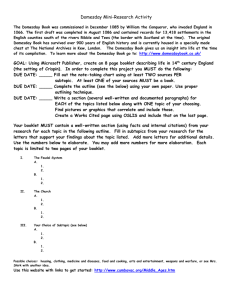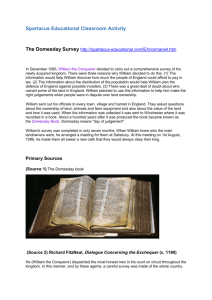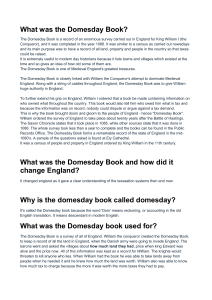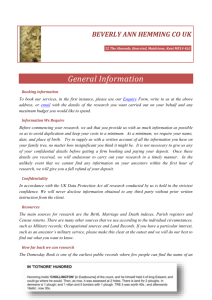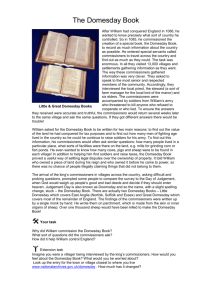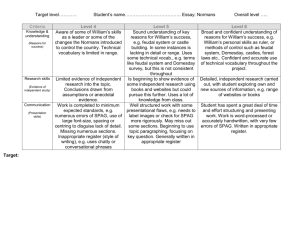Domesday Book Education Service
advertisement
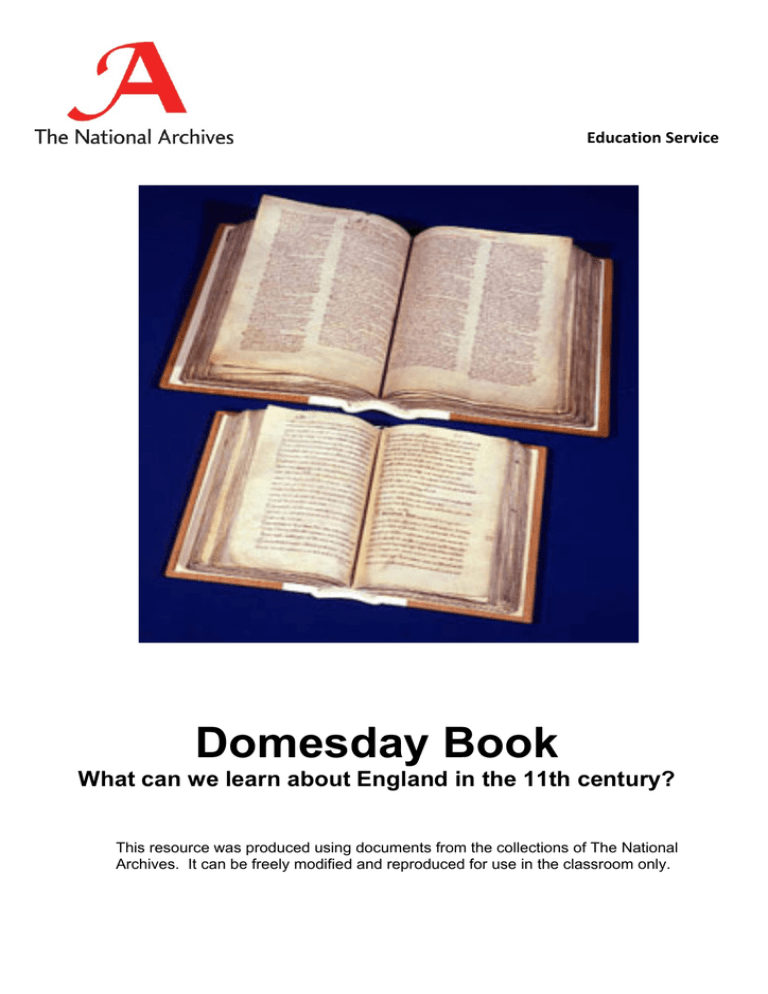
Education Service Domesday Book What can we learn about England in the 11th century? This resource was produced using documents from the collections of The National Archives. It can be freely modified and reproduced for use in the classroom only. Domesday Book : What can we learn about England in the 11th century? 2 Introduction Domesday Book is the oldest government record held in The National Archives. In fact there are two Domesday Books - Little Domesday and Great Domesday which together contain a great deal of information about England in the 11th century. In 1086, King William I (the Conqueror) wanted to find out about all the land in his new kingdom: who owned which property, who else lived there, how much the land was worth and therefore how much tax he could charge, so he sent official government inspectors around England to ask questions in local courts. Fixed questions were asked, such as what the place was called, who owned it, how many men lived there, how many cows were there and so on. For each property, the questions were asked three times to see what changes had happened over time so that the king would know about the lands in Edward the Confessor's time (before1066), who William I had given it to and what it was worth then, and finally what the situation was in 1086 at the time of the survey. All the results of these questions were handwritten into the Domesday Book by scribes. Tasks Read Source 1 1. Who holds Patcham after 1066? How did the change in ownership of land help William increase his control over the country? 2. What is a "hide"? • a type of peasant • a shelter • a measurement of land • a place where you cannot be seen? 3. How many oxen are there in the village? Remember each plough is pulled by a team of eight oxen. 4. How many people live in this village? 5. Make a list of all the people in the village, starting with those who hold the most land and ending with the poorest members of the village. 6. Name TWO jobs, apart from ploughing, which this source reveals. 7. Work out the number of acres of land in the village. Remember one hide = 120 acres; an acre is roughly the size of a football pitch. 8. What do you think the woodland was used for? 9. What was the value of the land when William the Conqueror became king in 1066? What had happened to its value by 1086? 10. Think about your answers for question 9. Why do you think King William was interested in knowing the value of the land? © Crown Copyright 2008 Domesday Book : What can we learn about England in the 11th century? 3 Background On 5 January 1066, Edward the Confessor, the King of England, died. Harold Godwin was crowned King of England. Two other men claimed that the throne belonged to them: Harold Hardrada, King of Norway; the other was William Duke of Normandy. Harold Hardrada invaded the north of England but the King managed to defeat his army. Shortly after, William - had landed in the south of England. On 14 October 1066, the English and Norman armies clashed in a battle just outside Hastings, in which Harold died - legend has it that King Harold was shot in the eye by an arrow! William, Duke of Normandy was crowned King of England on Christmas Day 1066. William took all the land and important jobs in the Government and Church away from the Saxons and divided it up amongst his Norman friends. He built castles to make the English feel so scared that they would not dare even to think about causing trouble. By 1085, William had a shortage of money and also many Normans had begun to disagree amongst themselves over the land they had been given as a reward for helping conquer England. William wanted to settle these disputes once and for all. Thus William decided to order a survey. The survey would list all the land in England. It would list who was looking after each area, what lands they had, and which other people lived there. Importantly, the survey would find out how much tax-money William could get from this land. Official government inspectors were sent around the country to gather information. The people in England spoke Saxon English and the Norman inspectors spoke French and Latin. A jury, which included the local important men such as the village priest and reeve who could understand the different languages, had to decide whether their neighbours were telling the truth. The results of this survey were written into Domesday Book. Great Domesday contains most of the counties of England and was written by one scribe and checked by a second. Little Domesday, which contains the information for Essex, Norfolk and Suffolk, was probably written first and is the work of at least six scribes. Domesday Book describes almost all of England and more than 13,000 places are mentioned in it. Most of them still survive today. London, Winchester, County Durham and Northumberland were not included in King William's survey. In spite of these omissions, the survey gives a wealth of information, as well as highlighting that a lot of property had been destroyed by William's invasion in 1066. Most of the land originally owned by 2000 Saxons belonged to 200 Norman barons in 1086, showing just how powerful the Norman lords had become! Teachers Notes This lesson could be used for History at Key Stage 3 (year 7), within Unit 2: How did medieval monarchs keep control? Section 2: How did William the Conqueror secure control of England? and Unit 3: How hard was life for medieval people in town and country? Section1: What does the Domesday Book tell us about life in town and country? The activities also support the Key stage 3 literacy strategy for the development of writing. Finally, the questions could also be used with Key Stage 2 pupils, fitting in with Unit 4 on Famous people as well as contributing to the Key Stage 2 numeracy strategy. The extension activities might be the basis for class discussion and group or individual work. © Crown Copyright 2008 Domesday Book : What can we learn about England in the 11th century? Sources Illustration: Photograph of open volumes of Little Domesday and Great Domesday (Catalogue ref: E31/1 and E 31/2) Source Image 1: Page from Vol. 1 of Great Domesday (Catalogue ref: E 31/2/1, f.26b) Source Image 2: Extract of page from Vol. 1 of Great Domesday, showing survey entry of Preston Hundred in Sussex (Catalogue ref: E 31/2/1, f.26b) Schemes of Work How did medieval monarchs keep control? Key stage 3, Unit 2 How hard was life for medieval people in town and country? Key Stage 3, Unit 3 © Crown Copyright 2008 4 Domesday Book : What can we learn about England in the 11th century? Source 1 : Page from Vol. 1 of Great Domesday (Catalogue ref: E 31/2/1, f.26b) © Crown Copyright 2008 5 Domesday Book : What can we learn about England in the 11th century? Extract of page from Vol. 1 of Great Domesday, showing survey entry of Preston Hundred in Sussex, (Catalogue ref: E 31/2/1, f.26b) © Crown Copyright 2008 6 Domesday Book : What can we learn about England in the 11th century? Source 1 : Transcript of Extract of page from Vol. 1 of Great Domesday, showing survey entry of Preston Hundred in Sussex, (Catalogue ref: E 31/2/1, f.26b) This extract, written in Latin, is from Great Domesday. It gives details about Preston Hundred in Sussex. IN PRESTETUNE HUND. Ipse Wills ten PICEHA in dnio . Herald tenuit . T.R.E. Tc se desd p LX . hid . m p . XL . Tra . e qt XX . car. In dnio. VIII . car. CXLX.III . uilli XL.V . bord cu qt XX II . car . Ibi aeccla .VI . serui . X . berquarij. Ibi qt XX IIII . ac pti . silua. c . porc. In Lewes . XXVI . hagae . de . XIII . solid. De hac tra ten Ricoard VII . hid . miles ej . I . hid dim. In dnio hnt .II. car . cu . II . bord. T.R.E.ualeb tot . c .lib . post . L . lib .m . qt XX . lib. Source 1 : Simplified transcript of Extract of page from Vol. 1 of Great Domesday, showing survey entry of Preston Hundred in Sussex, (Catalogue ref: E 31/2/1, f.26b) In PRESTON Hundred William holds PATCHAM himself, in lordship. Earl Harold held it before 1066. Then it answered for 60 hides; now for 40. Land for 80 ploughs. In lordship 8 ploughs; 163 villagers and 45 smallholders with 82 ploughs; A church; 6 slaves; 10 shepherds; meadow, 84 acres; woodland, 100 pigs; 26 sites in Lewes at 13s. Richard holds 7 hides of this land; and a man-at-arms of his 1/2 hides. In lordship they have 2 ploughs, with 2 smallholders. Total value before 1066 £100; later £50; now £80. © Crown Copyright 2008 7
